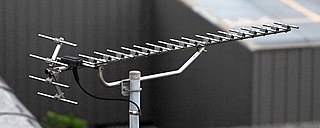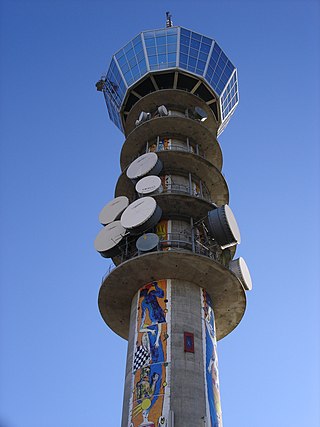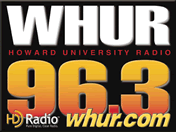Related Research Articles
Satellite radio is defined by the International Telecommunication Union (ITU)'s ITU Radio Regulations (RR) as a broadcasting-satellite service. The satellite's signals are broadcast nationwide, across a much wider geographical area than terrestrial radio stations, and the service is primarily intended for the occupants of motor vehicles. It is available by subscription, mostly commercial free, and offers subscribers more stations and a wider variety of programming options than terrestrial radio.

Very high frequency (VHF) is the ITU designation for the range of radio frequency electromagnetic waves from 30 to 300 megahertz (MHz), with corresponding wavelengths of ten meters to one meter. Frequencies immediately below VHF are denoted high frequency (HF), and the next higher frequencies are known as ultra high frequency (UHF).

Ultra high frequency (UHF) is the ITU designation for radio frequencies in the range between 300 megahertz (MHz) and 3 gigahertz (GHz), also known as the decimetre band as the wavelengths range from one meter to one tenth of a meter. Radio waves with frequencies above the UHF band fall into the super-high frequency (SHF) or microwave frequency range. Lower frequency signals fall into the VHF or lower bands. UHF radio waves propagate mainly by line of sight; they are blocked by hills and large buildings although the transmission through building walls is strong enough for indoor reception. They are used for television broadcasting, cell phones, satellite communication including GPS, personal radio services including Wi-Fi and Bluetooth, walkie-talkies, cordless phones, satellite phones, and numerous other applications.

XM Satellite Radio (XM) was one of the three satellite radio (SDARS) and online radio services in the United States and Canada, operated by Sirius XM Holdings. It provided pay-for-service radio, analogous to subscription cable television. Its service included 73 different music channels, 39 news, sports, talk and entertainment channels, 21 regional traffic and weather channels, and 23 play-by-play sports channels. XM channels were identified by Arbitron with the label "XM".

Radio broadcasting is the broadcasting of audio (sound), sometimes with related metadata, by radio waves to radio receivers belonging to a public audience. In terrestrial radio broadcasting the radio waves are broadcast by a land-based radio station, while in satellite radio the radio waves are broadcast by a satellite in Earth orbit. To receive the content the listener must have a broadcast radio receiver (radio). Stations are often affiliated with a radio network that provides content in a common radio format, either in broadcast syndication or simulcast, or both. Radio stations broadcast with several different types of modulation: AM radio stations transmit in AM, FM radio stations transmit in FM, which are older analog audio standards, while newer digital radio stations transmit in several digital audio standards: DAB, HD radio, DRM.
Air-ground radiotelephone service is a system which allows voice calls and other communication services to be made from an aircraft to either a satellite or land based network. The service operates via a transceiver mounted in the aircraft on designated frequencies. In the US these frequencies have been allocated by the Federal Communications Commission.
In-band on-channel (IBOC) is a hybrid method of transmitting digital radio and analog radio broadcast signals simultaneously on the same frequency. The name refers to the new digital signals being broadcast in the same AM or FM band (in-band), and associated with an existing radio channel (on-channel). By utilizing additional digital subcarriers or sidebands, digital information is multiplexed on existing signals, thus avoiding re-allocation of the broadcast bands.

Low-power broadcasting is broadcasting by a broadcast station at a low transmitter power output to a smaller service area than "full power" stations within the same region. It is often distinguished from "micropower broadcasting" and broadcast translators. LPAM, LPFM and LPTV are in various levels of use across the world, varying widely based on the laws and their enforcement.
Digital radio is the use of digital technology to transmit or receive across the radio spectrum. Digital transmission by radio waves includes digital broadcasting, and especially digital audio radio services.

Sirius Satellite Radio was a satellite radio (SDARS) and online radio service operating in North America, owned by Sirius XM Holdings.
The S band is a designation by the Institute of Electrical and Electronics Engineers (IEEE) for a part of the microwave band of the electromagnetic spectrum covering frequencies from 2 to 4 gigahertz (GHz). Thus it crosses the conventional boundary between the UHF and SHF bands at 3.0 GHz. The S band is used by airport surveillance radar for air traffic control, weather radar, surface ship radar, and some communications satellites, especially those satellites used by NASA to communicate with the Space Shuttle and the International Space Station. The 10 cm radar short-band ranges roughly from 1.55 to 5.2 GHz. The S band also contains the 2.4–2.483 GHz ISM band, widely used for low power unlicensed microwave devices such as cordless phones, wireless headphones (Bluetooth), wireless networking (WiFi), garage door openers, keyless vehicle locks, baby monitors as well as for medical diathermy machines and microwave ovens. India's regional satellite navigation network (IRNSS) broadcasts on 2.483778 to 2.500278 GHz.
1worldspace, known for most of its existence simply as WorldSpace, is a defunct satellite radio network that in its heyday provided service to over 170,000 subscribers in eastern, southern and northern Africa, the Middle East, and much of Asia with 96% coming from India. It was profitable in India, with 450,000 subscribers.
A broadcast license is a type of spectrum license granting the licensee permission to use a portion of the radio frequency spectrum in a given geographical area for broadcasting purposes. The licenses generally include restrictions, which vary from band to band.

WHUR-FM is an urban adult contemporary radio station that is licensed to Washington, D.C., and serving the Metro D.C. area. It is owned and operated by Howard University, making it one of the few commercial radio stations in the United States to be owned by a college or university, as well as being the only independent, locally-owned station in the Washington, D.C., area. Staff members of the station mentor the students of the university's school of communications. The studios are located on campus in its Lower Quad portion, and the transmitter tower is based in the Tenleytown neighborhood. It is also co-owned with its television partner, WHUT-TV, one of D.C.'s PBS affiliates.
Sirius XM Holdings Inc. is an American broadcasting corporation headquartered in Midtown Manhattan, New York City, that provides satellite radio and online radio services operating in the United States. The company was formed by the 2008 merger of Sirius Satellite Radio and XM Satellite Radio, merging them into SiriusXM Radio. The company also has a 70% equity interest in Sirius XM Canada, an affiliate company that provides Sirius and XM service in Canada. On May 21, 2013, Sirius XM Holdings, Inc. was incorporated, and in January 2020, SiriusXM reorganized their corporate structure, which made Sirius XM Radio Inc. a direct, wholly owned subsidiary of Sirius XM Holdings, Inc.
Primosphere Limited Partnership was one of four companies bidding for Satellite Digital Audio Radio Service, or SDARS, licenses in the United States. The service would have been an advertisement-supported digital audio service with an emphasis on serving music genres that had lost exposure in the terrestrial radio market during that period, such as classic jazz, "beautiful music," "pop standards," and swing music. Two dedicated public radio talk channels were also proposed along with traditional talk radio channels.
The 13 centimeter, 2.3 GHz or 2.4 GHz band is a portion of the UHF (microwave) radio spectrum internationally allocated to amateur radio and amateur satellite use on a secondary basis. The amateur radio band is between 2300 MHz and 2450 MHz, and thereby inside the S-band. The amateur satellite band is between 2400 MHz and 2450 MHz, and its use by satellite operations is on a non-interference basis to other radio users. The license privileges of amateur radio operators include the use of frequencies and a wide variety of modes within these ranges for telecommunication. The allocations are the same in all three ITU Regions.
The digital dividend refers to the radio spectrum which is released in the process of digital television transition. When television broadcasters switch from analog TV to digital-only platforms, part of the electromagnetic spectrum that has been used for broadcasting will be freed-up because digital television needs less spectrum than analog television, due to lossy compression. One reason is that new digital video compression technology can transmit numerous digital subchannels using the same amount of spectrum used to transmit one analog TV channel. However, the primary reason is that digital transmissions require much less of a guard band on either side, since they are not nearly as prone to RF interference from adjacent channels. Because of this, there is no longer any need to leave empty channels to protect stations from each other, in turn allowing stations to be repacked into fewer channels, leaving more contiguous spectrum to be allocated for other wireless services.

The C band is a designation by the Institute of Electrical and Electronics Engineers (IEEE) for a portion of the electromagnetic spectrum in the microwave range of frequencies ranging from 4.0 to 8.0 gigahertz (GHz). However, the U.S. Federal Communications Commission C band proceeding and auction, designated 3.7–4.2 GHz as C band. The C band is used for many satellite communications transmissions, some Wi-Fi devices, some cordless telephones, as well as some radar and weather radar systems.
Wireless Communications Service (WCS) is a set of frequency bands designated in the United States and Canada in the 2305–2320 and 2345–2360 MHz spectrum range. The most common use of WCS spectrum is mobile voice and data services, including cell phone, text messaging, and Internet.
References
- ↑ Erskine, Daniel H. (2007-05-20). "Satellite Digital Audio Radio Searching for Novel Theories of Action". Rochester, NY. SSRN 987358.
{{cite journal}}: Cite journal requires|journal=(help) - ↑ Bruce Elbert, "Satellite Radio – Accomplishments, Opportunities and Risks," SatMagazine.com, March 2005, "Satellite Radio (SDARS) - Accomplishments, Challenges and Risks - Bruce Elbert, Satellite Expert and Consultant". Archived from the original on 2008-05-09. Retrieved 2008-05-07.
- ↑ "Worldspace Corporate Information". 1WorldSpace.com. Archived from the original on 2008-07-19.
- ↑ "Establishment of Rules and Policies for the Digital Audio Radio Satellite Service in the 2310-2360 MHz Frequency Band" (PDF).
- ↑ "Wireless Communications Service (WCS)". Federal Communications Commission. 16 October 2012.
- ↑ http://dev.space.com/spacenews/archive95/sn1995.fff1476.html Archived 2003-06-06 at the Wayback Machine FCC sets aside spectrum for SDARS